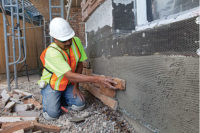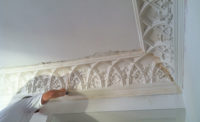The Process of Manufactured Stone
The process of taking all the qualities of stone and adding some touches to it that nature cannot.












Man has been playing and working with stone since the beginning of time. Whether to make a weapon to hunt for food, build a shelter or wall, channel water from a river, or even slay a giant. Man has had rocks in his hands or head for centuries.
Man was stacking stone well before bricks, before plaster, and before EIFS. The manufactured stone industry is now helping improve the appeal and performance of stone.
Why Not Natural Stone?
Natural stone is quarried. Natural stone is unique in style and color based upon where it comes from. I live in Texas so stone has names like San Saba Sandstone, Antique Leuders, Sisterdale Cream, etc. These are all the cities where the quarries are unique in their color blend from that region. A cream in Sisterdale would be different than a cream in San Saba. Color comes out the way nature produced it and thus has its limitations.
The amount of stone is limited to the levels of certain types in the quarry and also the amount of other stone you must go through to get to those levels. Weather plays a big factor too. Quarries can be shut down for weeks after rain due to water filling the quarry holes.
The first thing to clarify is that you don’t need to be a mason to put up manufactured veneer stone. If you can read a tape measure, run a chalk line, and have basic construction skills you can install it. A whole new world of exterior options are available to masons, plasterers, patio and pool installers, and weekend warriors. Many of the manufactures they buy products from are getting into this part of the construction industry. This is not just an exterior business. Hotel lobbies, hallways, fireplaces, and so many other areas are all now using manufactured stone or brick.
All that is required of the contractor is that he expands his scope of work. How hard would it to be for a plastering company to hire a mason that needs work and at the same time you are training him to be a plasterer he is showing you how to work with stone? It may be a little too out of the box for some, but the same thing was said when the stucco industry was introduced to fluid applied membranes. That was strictly the waterproofing business, but how many stucco or EIFS contractors are applying that on a regular basis? How many stucco and EIFS manufacturers make the weather membranes?
Why Manufactured Stone?
Manufactured stone has many reasons for its growing popularity over natural stone. Among them more consistent color and stone size, the back of the stone is keyed to tie in better to the scratch coat than smooth faced natural stone, thus the mortar also adheres better to the manufactured stone and the system itself is warranted by the stone, sheathing and mortar manufacturer. It is a system warranty. This in turn brings stucco and EIFS manufacturers into the system picture. Add to this continuous insulation and you now have a whole new market.
Continuous insulation became the Golden Child of the exterior construction industry when green and LEED points became more of the standard than the exception for building codes. The ability of continuous insulation to block thermal bridging and help prevent heat loss and maintain higher R-values is significant. We are just in the beginning stages of this new building concept and where it goes will be very exciting.
With manufactured stone’s many color and style possibilities, the ability to work with so many different types of exterior coatings and claddings, it is no surprise that the stucco and EIFS manufactures had no choice but to come up with systems that will work in conjunction with this manufactured stone. You will now see exterior warranties ranging from five to 50 years or more for manufactured stone. You will never see that with natural stone. Sorry, but nature doesn’t come with a warranty.
What you get with manufactured stone are products that are featured on an ever increasing amount of restaurants, hotels, shopping centers and multifamily projects. It is a standard feature on most wainscoting for tract homes. You can’t watch a fixer upper or remodel show and not find some type of manufactured product in the project. What patio or backyard barbeque doesn’t have some type of manufactured stone or thin brick on it?
Yes, let’s not forget thin brick—another bullet in the gun of the manufactured stone industry. Brick was the first manufactured stone that man created out of clay or adobe. The thin brick allows the architects the ability to place it in areas where the look is desired but the job conditions would not allow full brick in normal circumstances. This passes on to the owner a cost and time savings.
When using manufactured stone the architect and designer have the ability to give the client the look of a Tuscan Villa, a French farmhouse, or an English castle without the massive sizes of the stone, the extra costs for foundation, and a much simpler and faster construction process. Who doesn’t want that?
What we now have is a dynamic and great opportunity for architects to get more design options, contractors to grow and increase business, and the weekend warrior homeowner the economical way to remodel and enhance their home.
Manufactured stone—the retail and commercial markets’ new best friend.
Looking for a reprint of this article?
From high-res PDFs to custom plaques, order your copy today!














